- Excellent touchscreen
- One of the best CVTs we have driven
- Great design inside and out
- Lacks some key features
- Not the cheapest car in segment
- No rear air vents
The Hyundai Kona has been for sale locally now for five years and has been a great success for the brand. Sitting above the smaller Hyundai Venue and below the mid-sized Hyundai Tucson, the Kona is the second-smallest SUV in the Hyundai range. The Kona sits in a market that is already quite populated as there is a plethora of rivals, including the Mazda CX-3, Mitsubishi ASX, Nissan Juke and Toyota Yaris Cross. We tested the mid-spec 2021 Hyundai Kona Elite to see how it stacks up against the competition.
For the 2020 model year Hyundai facelifted the Kona with new front end styling, a new interior design and some new technology. The Kona is for drivers who want an SUV and to be up higher than in a hatchback, but also don’t want a stonking big car that will be difficult to drive and navigate city streets.
Price & Specs: 8/10
The Hyundai Kona range starts off with the base car which is just dubbed ‘Kona’, it starts at $26,600 plus on-road costs ($28,990 drive away) which is somewhat low for the segment. The entry level Nissan Juke ST starts at $27,990 plus on-road costs – but the Mitsubishi ASX starts at very low $23,990 plus on-road costs.
The model we tested here is the mid-spec 2021 Hyundai Kona Elite which is priced at $31,600 plus on-road costs. Rivals to the Kona Elite are the $30,990 Mitsubishi ASX GSR, the $30,840 Mazda CX-3 sTouring, the $30,740 Nissan Juke ST+ and the $29,990 Toyota Yaris Cross GXL.
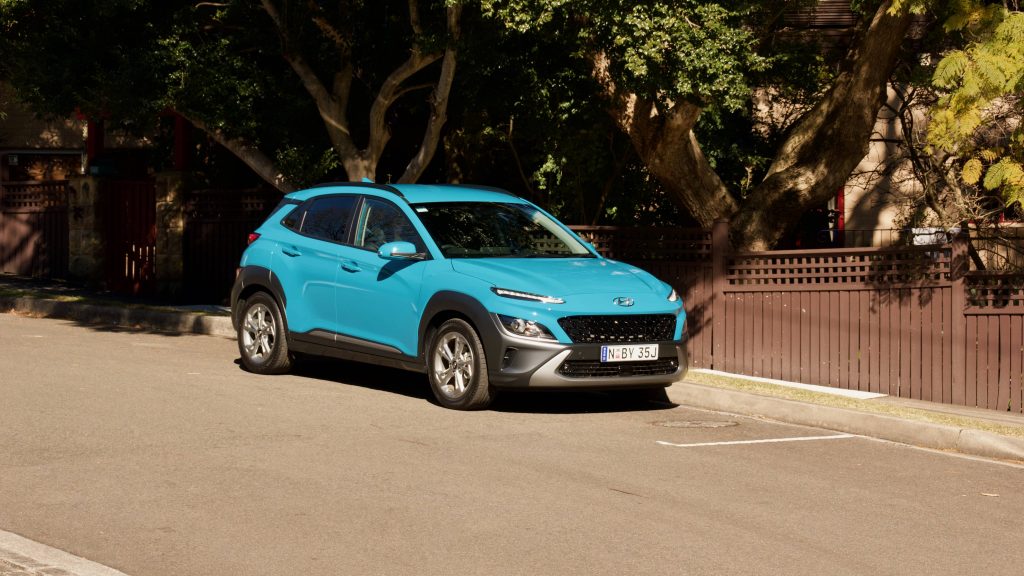
For a small SUV to be a success it needs to have a good amount of standard kit and well the Kona Elite definitely delivers. You get 17-inch alloy wheels, a 10.25-inch touchscreen with wired Apple CarPlay and Android Auto, satellite navigation, live traffic updates, digital radio, an eight-speaker Harmon Kardon sound system, single-zone climate control, automatic halogen headlights, LED daytime running lights, front and rear fog lamps, rain-sensing wipers, keyless entry with push button start, remote start, drive mode selection, leather upholstery, a leather steering wheel and gear knob, auto-folding and heated mirrors and wireless smartphone charging as standard.
There is quite a good amount of standard kit with the 2021 Hyundai Kona Elite and it doesn’t stop there. The standard safety features are plentiful and include adaptive cruise control, automatic high beam, tyre pressure monitoring, an alarm, lane departure warning, lane keep assist, autonomous emergency braking (AEB) with pedestrian and cyclist detection, rear cross traffic alert, forward collision alert, driver attention detection, rear parking sensors with a rear view camera and six airbags for a five-star ANCAP safety rating.
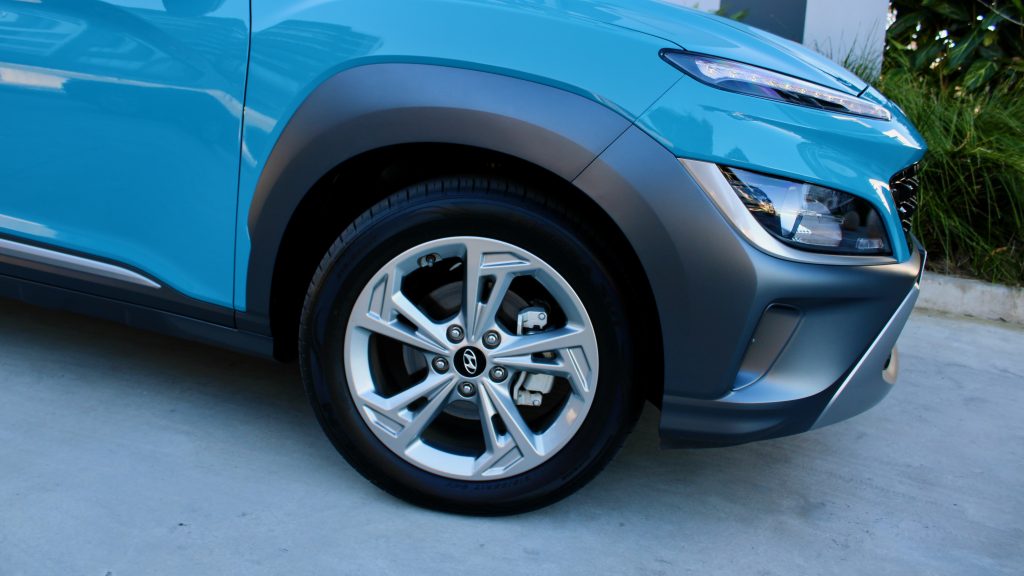
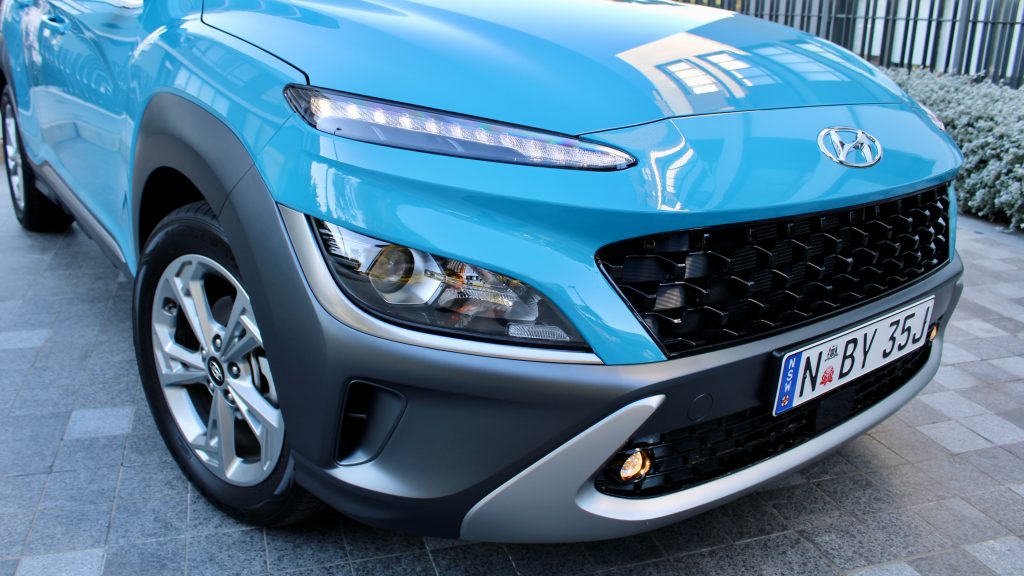
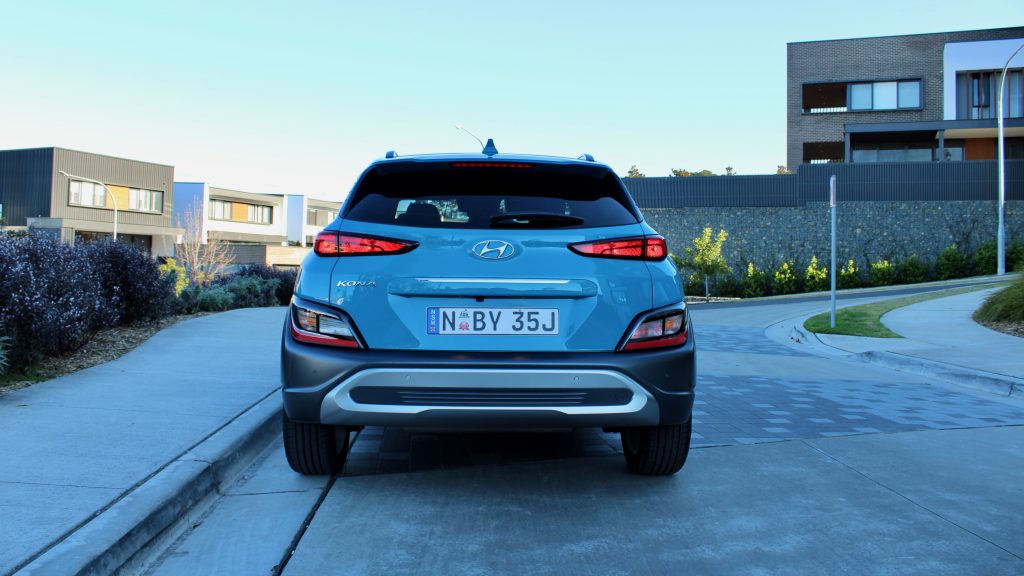
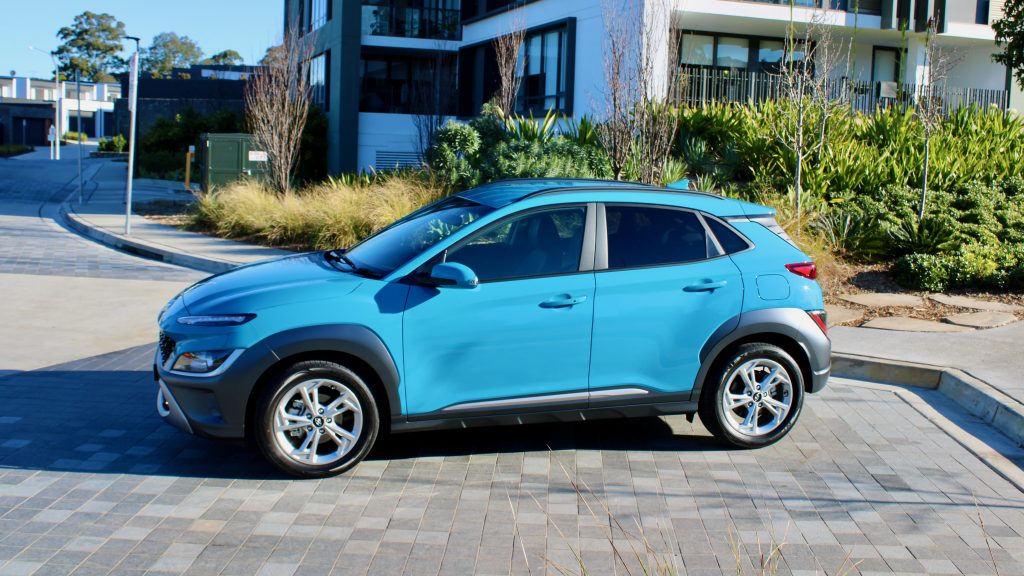
We think the 2021 Hyundai Kona Elite offers the perfect mixture of standard features for the right price. It is the Kona to choose as the cheaper models lack key features and the higher models are pricey. In saying this, how does the Kona Elite stand up to its rivals? The Mazda CX-3 sTouring has front parking sensors, LED headlights, dual-zone climate control, automatic high beam, larger 18-inch alloy wheels and speed sign recognition over the Kona. The Nissan Juke ST+ has roughly the same amount of features as the Kona but the Mitsubishi ASX GSR lacks key safety features that come as standard on the Kona.
Unfortunately the 2021 Hyundai Kona Elite misses out on dual-zone climate control, LED headlights, auto high beam, LED tail lights, wireless Apple CarPlay and Android Auto and an electric driver’s seat that should be standard for the price. It is strange that the cheapest car Hyundai make – the Venue – comes with both auto high beam and wireless Apple CarPlay and Android Auto as standard, even on the entry-level model. LED lights should be standard on all Konas as their beam is far superior to Hyundai’s typically lacklustre halogen set ups.
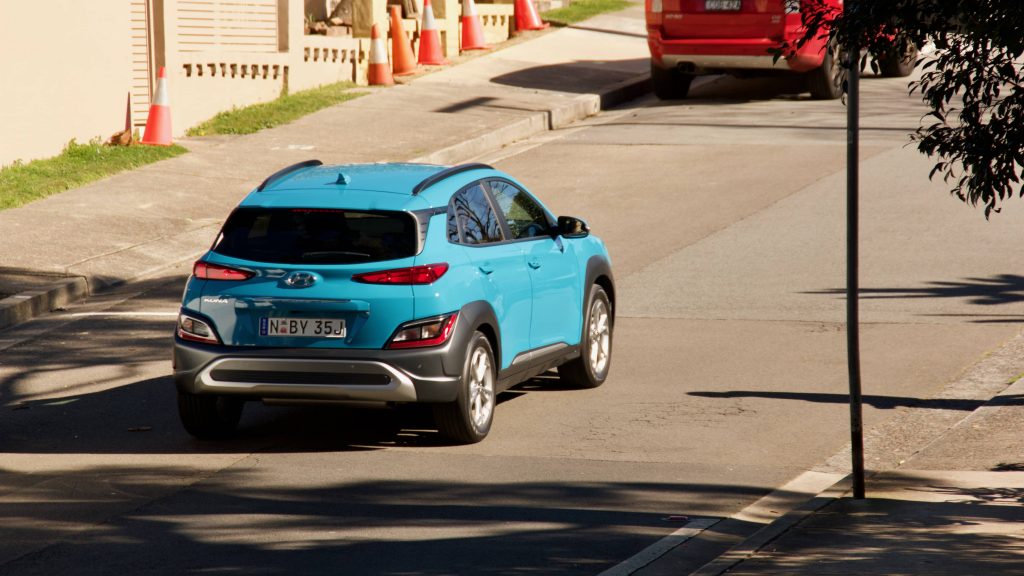
The standard colour on the 2021 Hyundai Kona Elite is ‘Dive In Juju’ (turquoise) and all other colours come at an additional $595 cost. These colours include ‘Phantom Black’, ‘Dark Knight’, ‘Pulse Red’, ‘Atlas White’ and our test car’s ‘Surfy Blue’.
Performance & Economy: 7/10
Like all standard Konas, the 2021 Hyundai Kona Elite comes with the brand’s familiar 2.0-litre naturally aspirated four-cylinder – though this engine is now part of the ‘Smartstream’ family. The engine produces 110kW of power and 180Nm of torque, which are healthy numbers for a small SUV – a Juke has just 88kW, for example. Power is sent to the front wheels through a continuously variable transmission (CVT). There is no manual option for the Hyundai Kona.
The engine actually feels rather positive when behind the wheel – you don’t feel like you are in an underpowered car. The engine is on the noisier side when accelerating and especially when out on the open road, but around town, you barely hear it. The CVT gearbox is one of the best we have experienced as there is none of the disconnected rubbery feeling that is associated with CVT gearboxes. The only gripe we have with the transmission is that at speed when you accelerate it really brings out the vocal nature of the engine. But when you do, it’s reasonably quick.
If you want more speed our of your Kona, there is also the Hyundai Kona N Line and N Line Premium which are powered by a 1.6-litre turbocharged four-cylinder engine that drives the front wheels through a seven-speed dual-clutch automatic transmission. The engine produces 146kW of power and 265Nm of torque. Above the N Line sits the 206kW Kona N as well, if you were wondering.
The Mazda CX-3 offers a 2.0-litre four cylinder engine just like the Kona with the same amount of power at 110kW, but it has 195Nm of torque to the Kona’s 180Nm. Unlike the Kona, the standard transmission in the CX-3 is a six-speed manual – a six-speed automatic is also available. The Nissan Juke has a 1.0-litre three-cylinder engine paired to a seven-speed dual-clutch transmission. The engine produces 88kW of power and 180Nm of torque. The CX-3 feels more spritely than the Kona most likely due to the more conventional transmission options and the higher torque figure.
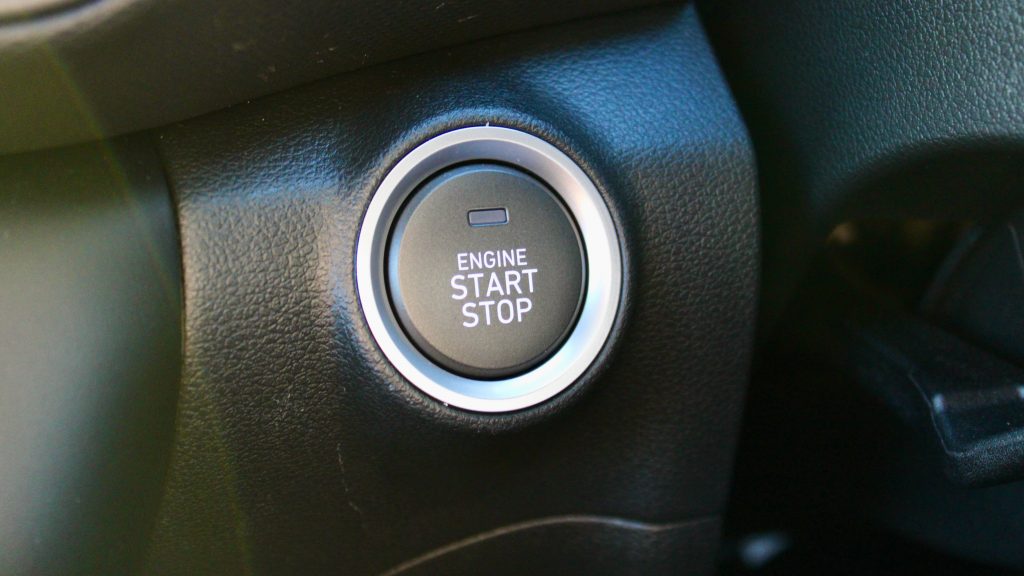
The claimed average fuel economy figure of the 2021 Hyundai Kona Elite is 6.2L/100km which is quite good for an SUV. Our time spend in the Kona with a mixture of highway and city driving saw a figure of 8.0L/100km, which is better than the previous Kona and we think the reason the 2021 Hyundai Kona Elite is more fuel efficient than its predecessor is due to its new CVT transmission. In comparison the Mazda CX-3 sTouring automatic has a claimed average of 6.3L/100km and the Nissan Juke ST+ has a claimed average of 5.8L/100km.
Ride & Handling: 8.5/10
Thanks to the local tune of the suspension the 2021 Hyundai Kona Elite drives rather well. It handles Australia’s quite average roads very well – it offers a composed ride that isn’t too firm to be uncomfortable, but not too soft to feel like it is floating. The Kona tackles potholes and speed humps like a champ with very little disruption into the cabin. When sitting in the rear of the Kona you do feel the firmer side of the ride but only just. The Kona is still easily more comfortable than a Mitsubishi ASX and Mazda CX-3.
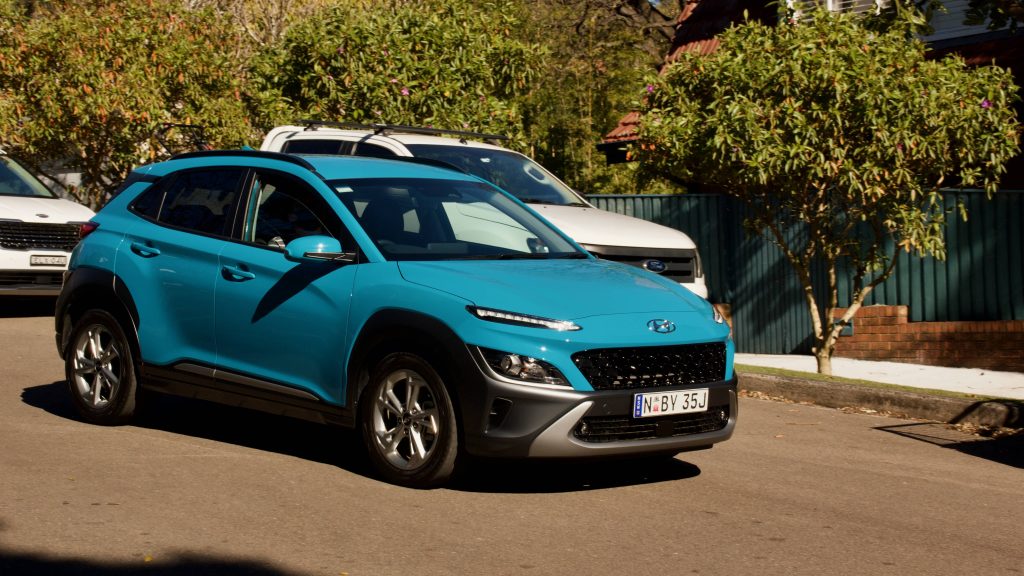
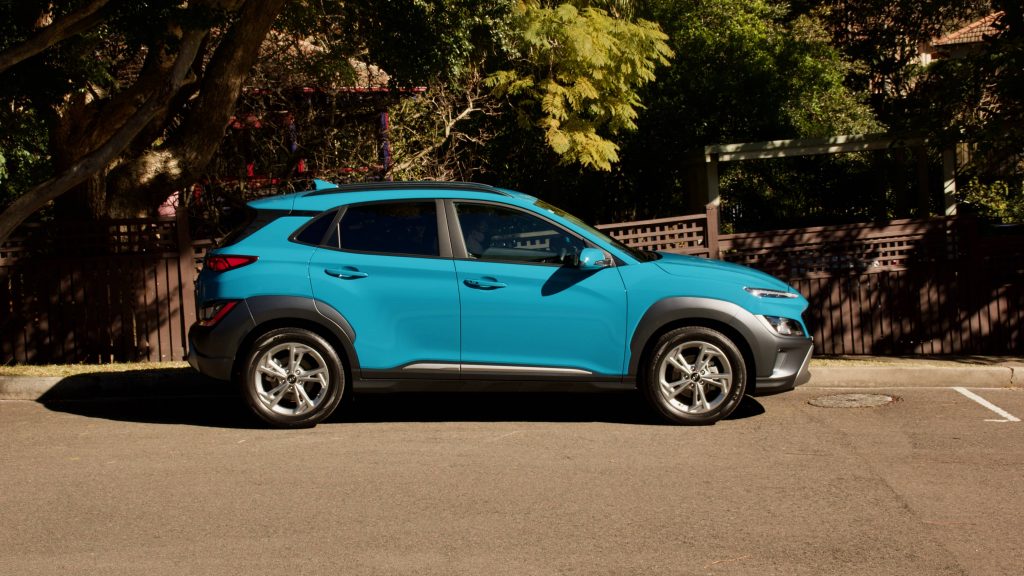
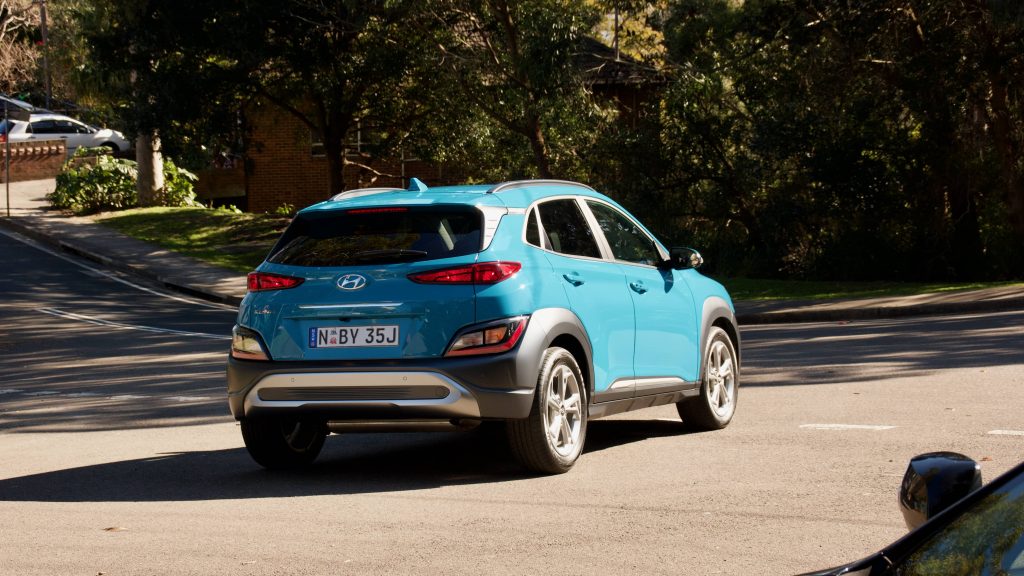
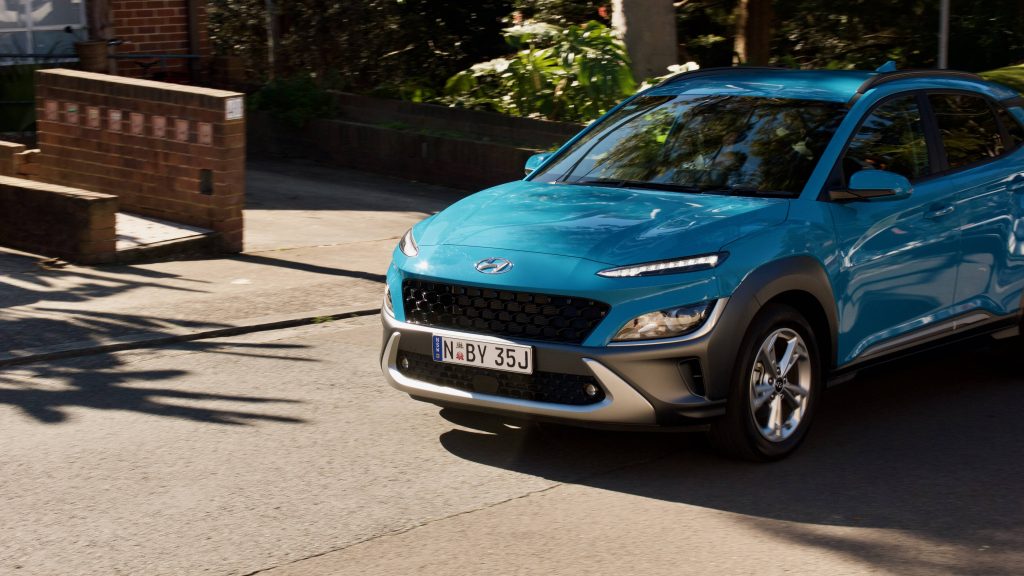
The Kona does have a lot of road noise when on the move and especially at speed, the Mazda CX-3 is definitely quieter, but both of these cars are quieter than the ancient Mitsubishi ASX. The handling ability of the Kona is actually quite surprising – the Kona is not as dynamic as the CX-3 but it can hold its own when thrown into a corner. There is slight body roll when cornering at speed but not enough to make you feel like you’re losing control.
The active safety features in the 2021 Hyundai Kona Elite work very well behind the scenes without interfering with driving. Being a Hyundai, they all work without flaw except for the lane departure warning system which can be a tad over sensitive when driving at slower speeds or in the suburbs. Out on the open road it works well but around town it can get a little annoying.
Interior & Practicality: 8/10
Small SUVs aren’t known for their interior space but the 2021 Hyundai Kona Elite offers more space than you’d expect thanks to its excellent packaging. There is also a nicer design to the interior compared with the previous Kona as it just makes the cabin feel a little more premium with features such as an electronic handbrake.
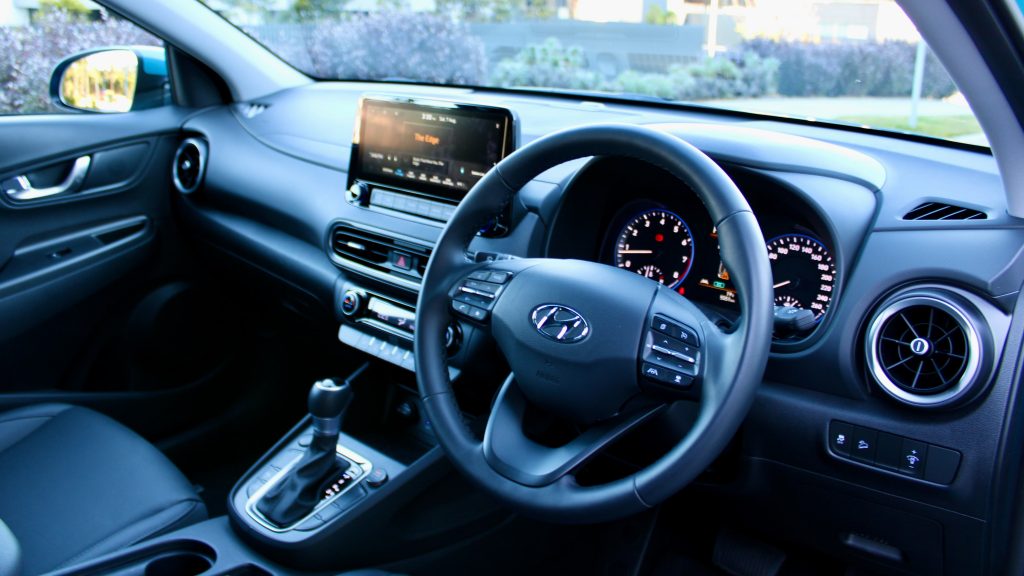
The one let down in the 2021 Hyundai Kona Elite’s cabin is that the quality of materials used could be a little better. as there are hard plastics covering most of the cabin, which makes what it feel quite cheap. The dash (bar one portion), door panels and centre console are all hard plastic and some of the switchgear – such as the window controls – use tinny plastics. The faux leather used on the upholstery for the seats, steering wheel and gear knob is rather good though – to the untrained eye, it feels just like real leather.
The practicality in the Kona is rather good as there is interior storage nearly everywhere you look. In front of the gear knob, there is a wireless smartphone charger and a deep cavity to store a wallet, behind the gear selector there are two cup holders and also another cubby that is the perfect size for a mobile phone or wallet. There are also deep door bins, a large centre console and a decently sized glovebox.
The 10.25-inch touchscreen, which is seen in many other Hyundai products, works a treat and sits well above the dash. There are shortcut keys under the screen to navigate between different menus and there are also a physical volume and seeking knobs. The screen resolution looks good and there is rarely any delay with the system itself. Unlike the entry level Konas, there is no wireless Apple CarPlay and Android Auto with the larger screen.
Sitting in the back of the 2021 Hyundai Kona isn’t as bad as you may think as there is a decent amount of leg and head room for taller passengers. There is also enough room across the Kona to accommodate three small-to-medium-sized teenagers. There is a rear centre armrest with cupholders to make sitting in the back more comfortable but unfortunately, no rear air vents. There is one USB-A charging port in the rear but this means that the kids in the back will have to fight over whose phone needs charging.
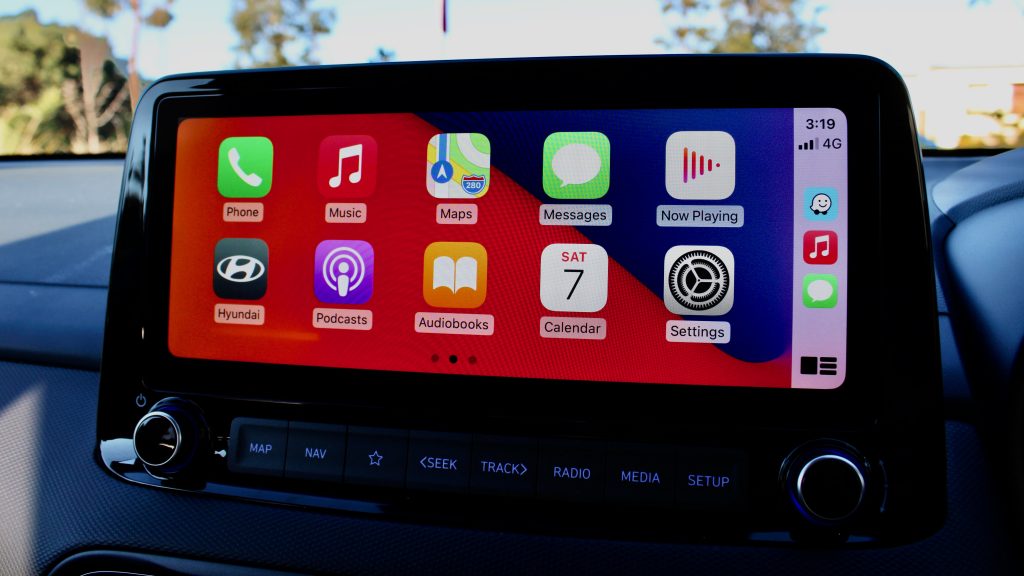
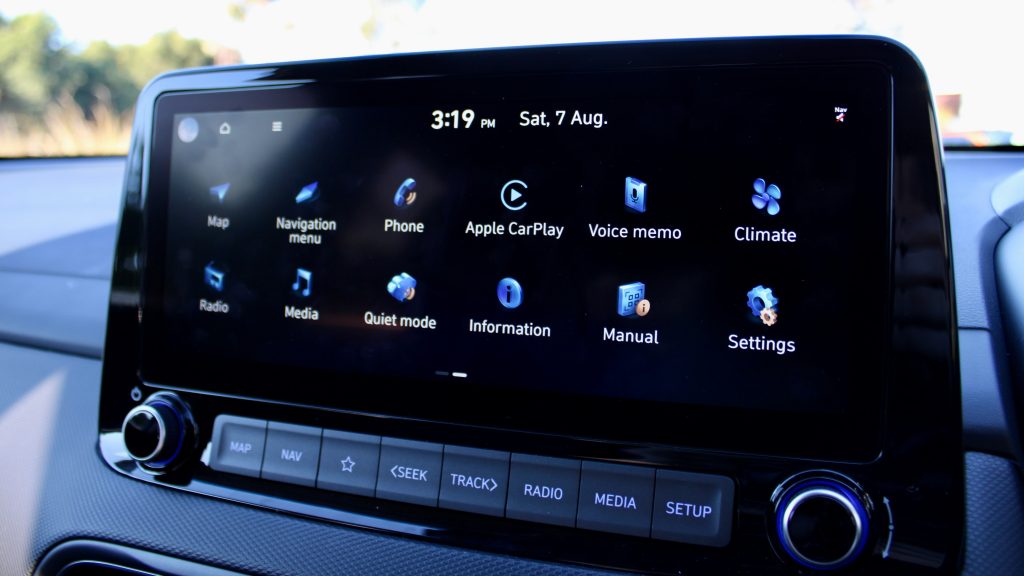
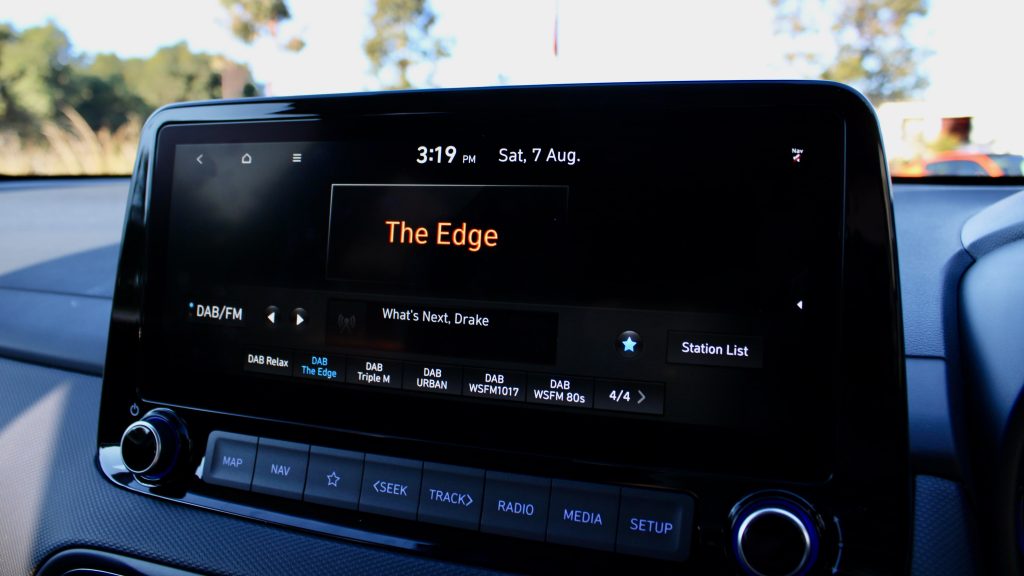
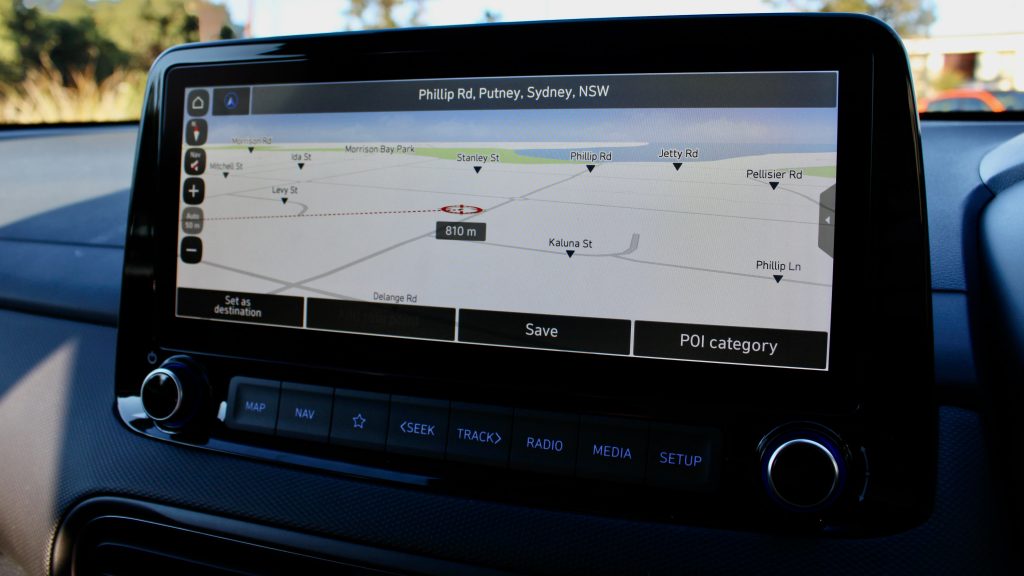
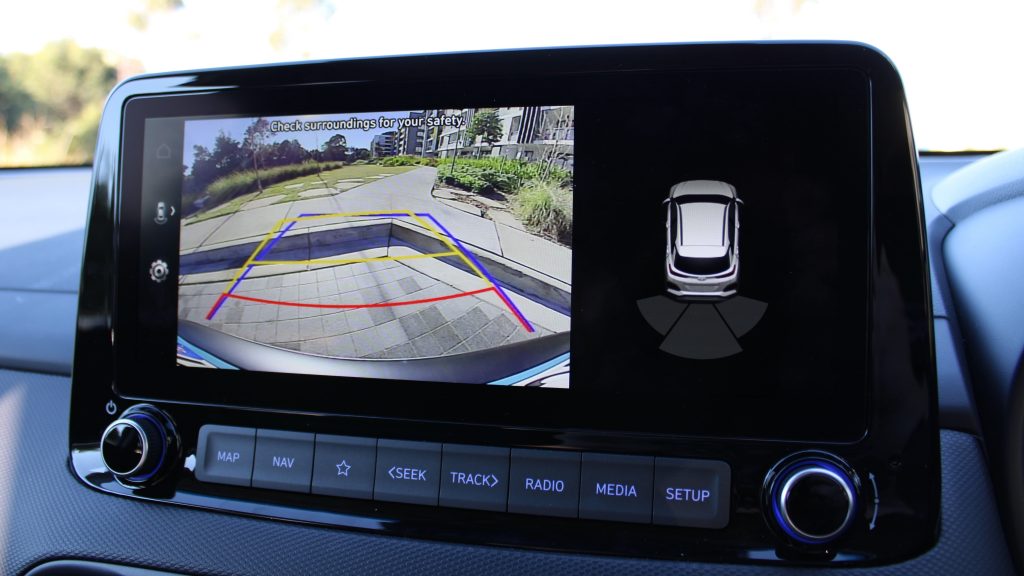

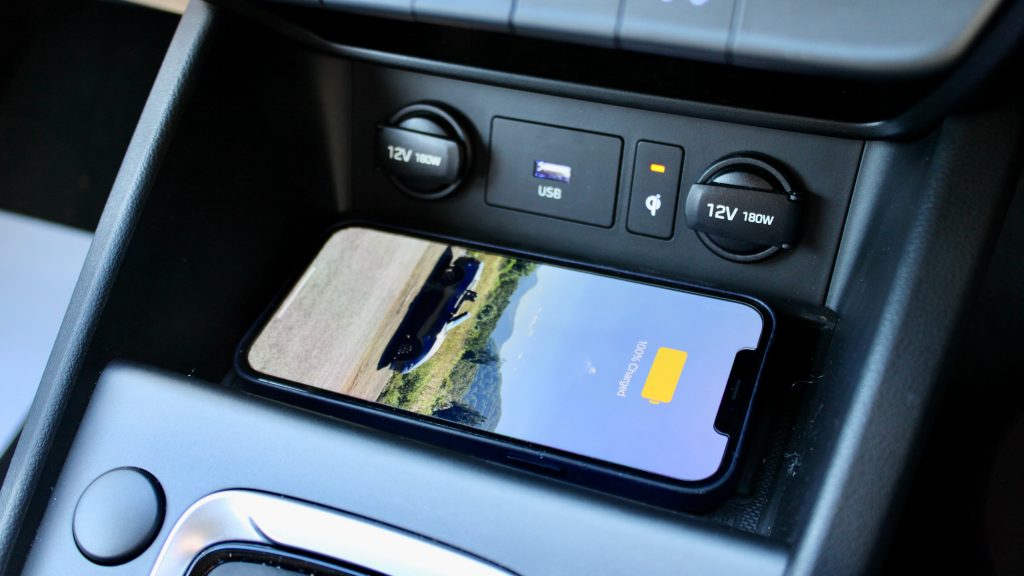
The boot of the Kona can hold 374-litres of cargo space and there is also a net on the boot floor that can be used to hold items down so they don’t move around. Folding the rear seats down and taking the cargo cover out opens the space up to 1,156L, which is a good size. In comparison, the Mazda CX-3 has a boot capacity of 264-litres with the rear seats in place and 1,174L with them folded.
Service & Warranty: 8/10
Like all other Hyundai products, the 2021 Hyundai Kona Elite comes with the brand’s five-year/unlimited kilometre warranty. This is on par with what is offered on the Mazda CX-3, Nissan Juke and Toyota Yaris Cross although it is worth noting that the Yaris Cross has a further two years of warranty on the engine if serviced at Toyota. The only other car in the segment that has a better warranty is the Mitsubishi ASX, which has a 10-year 200,000km warranty – again, only if serviced through Mitsubishi. The Kona comes with 12 months of roadside assist from new but this is further extended by 12 months at every scheduled service for up to five years. The Mazda CX-3 and Nissan Juke both come with five years worth of roadside assist, whereas the Toyota Yaris Cross doesn’t come with any form of roadside assist at all.
The 2021 Hyundai Kona Elite requires being serviced every 12-months or 15,000km – these intervals are average for the new car market these days. The Toyota Yaris Cross and the Mitsubishi ASX share these intervals, whereas the Mazda CX-3 requires servicing more often at 12 months or every 10,000km. The Kona will set owners back $1,595 over the span of five years or 75,000km ($319 for each service). In comparison, the Toyota Yaris Cross will set owners back just $1,075 which each of the first five services costing $215. The Mazda CX-3 will cost $1,775 to service over five-years or 50,000km, which is an average service cost of $355.
2021 Hyundai Kona Elite SUV DiscoverAuto Rating: 7.9/10
Style, practicality, comfort and a good amount of standard features, the 2021 Hyundai Kona Elite is sure to impress. The Kona offers more than enough for the average small family or couple, there is plentiful interior space and more than enough safety tech to put your mind at ease. The Kona shows that SUVs don’t have to be boring, with it’s funky exterior styling and well packaged interior there is a lot to love about Hyundai’s second smallest SUV.
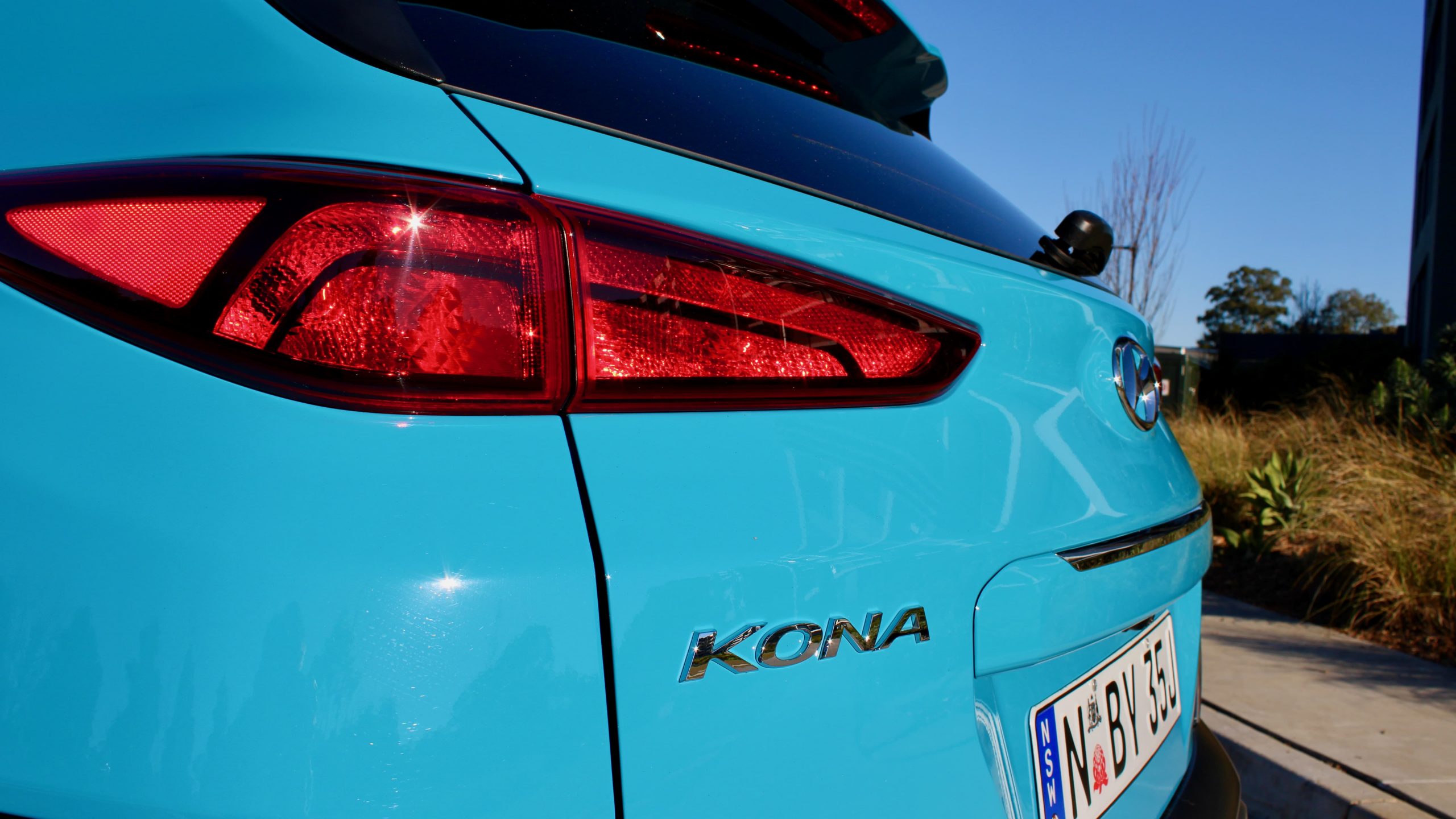
Would we buy a 2021 Hyundai Kona Elite? Yes, out of the current crop of small SUVs, we think the Kona offers the perfect amount of equipment, practicality, engine and value for money to stay ahead. It isn’t the cheapest to service and the interior build quality could be better, but these are small shortcomings to what is a great SUV.
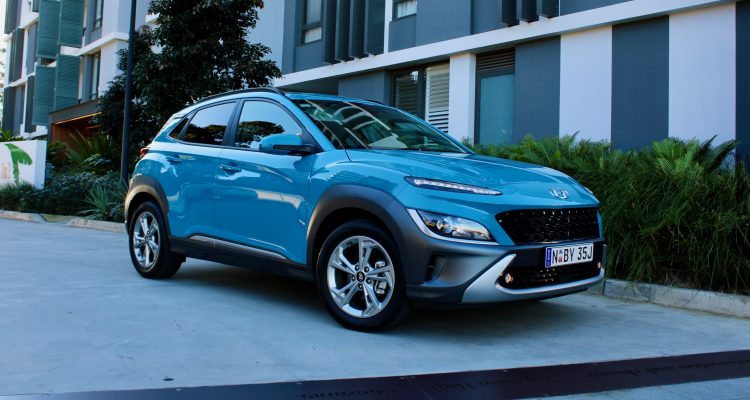
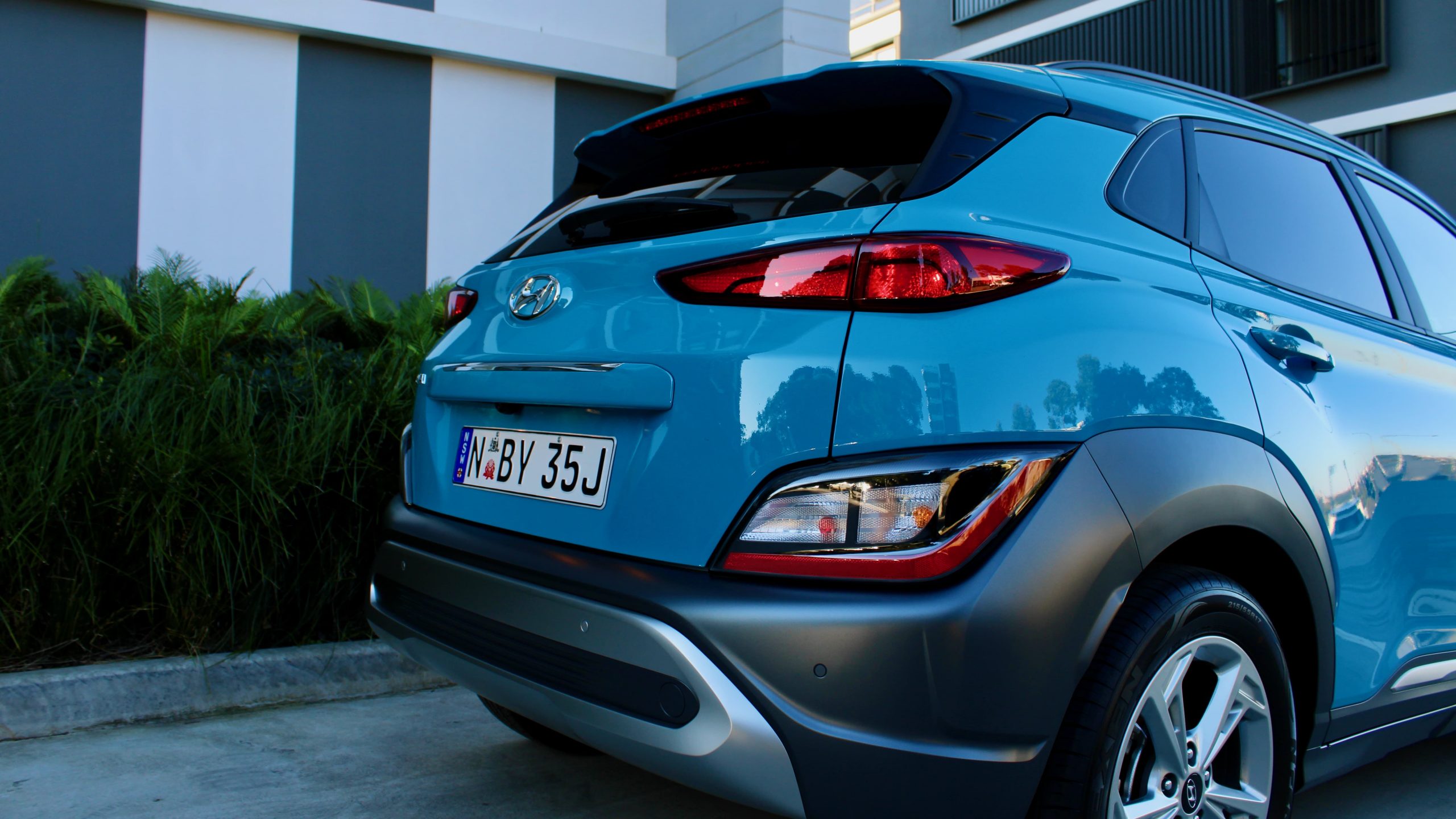
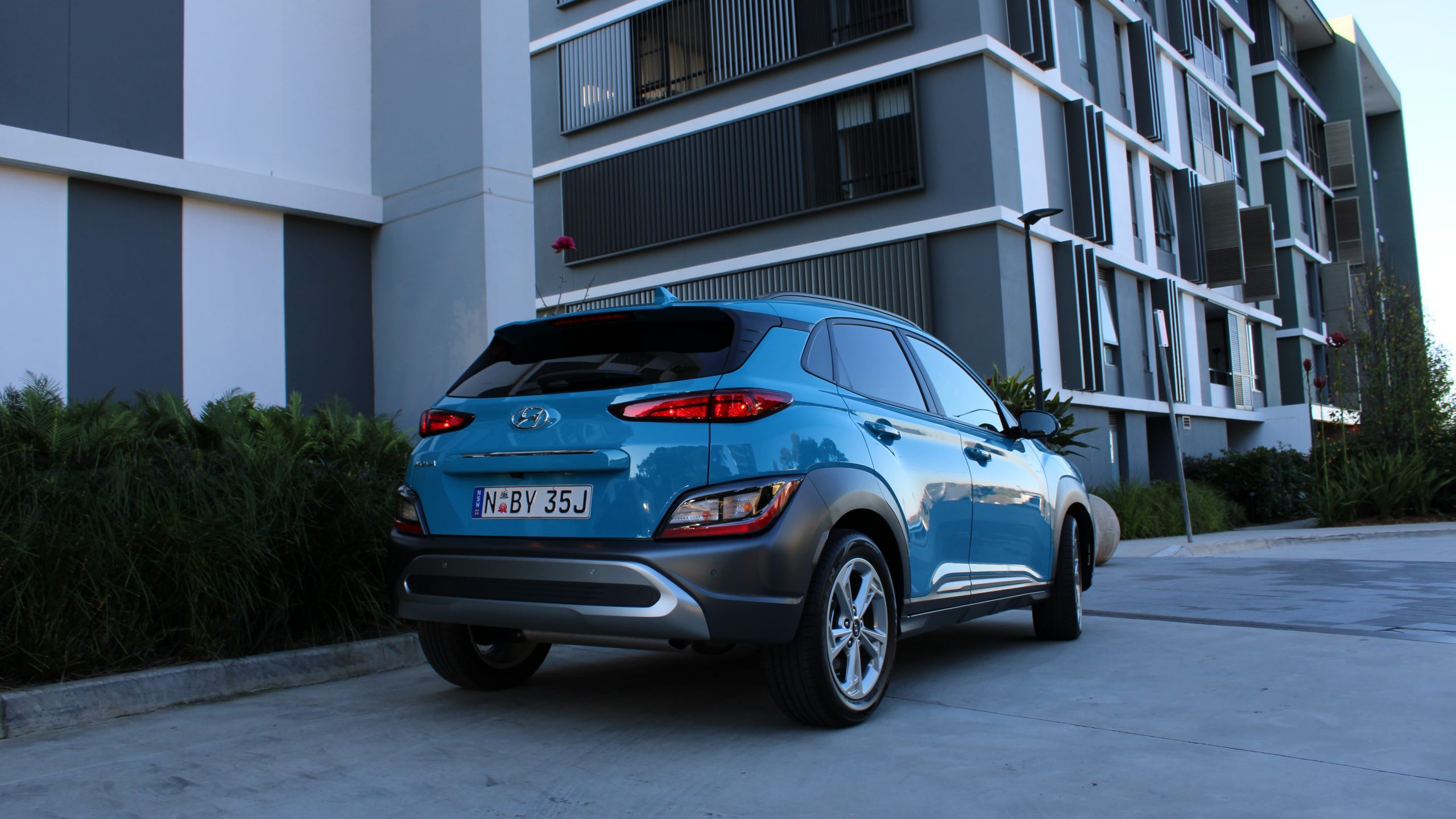
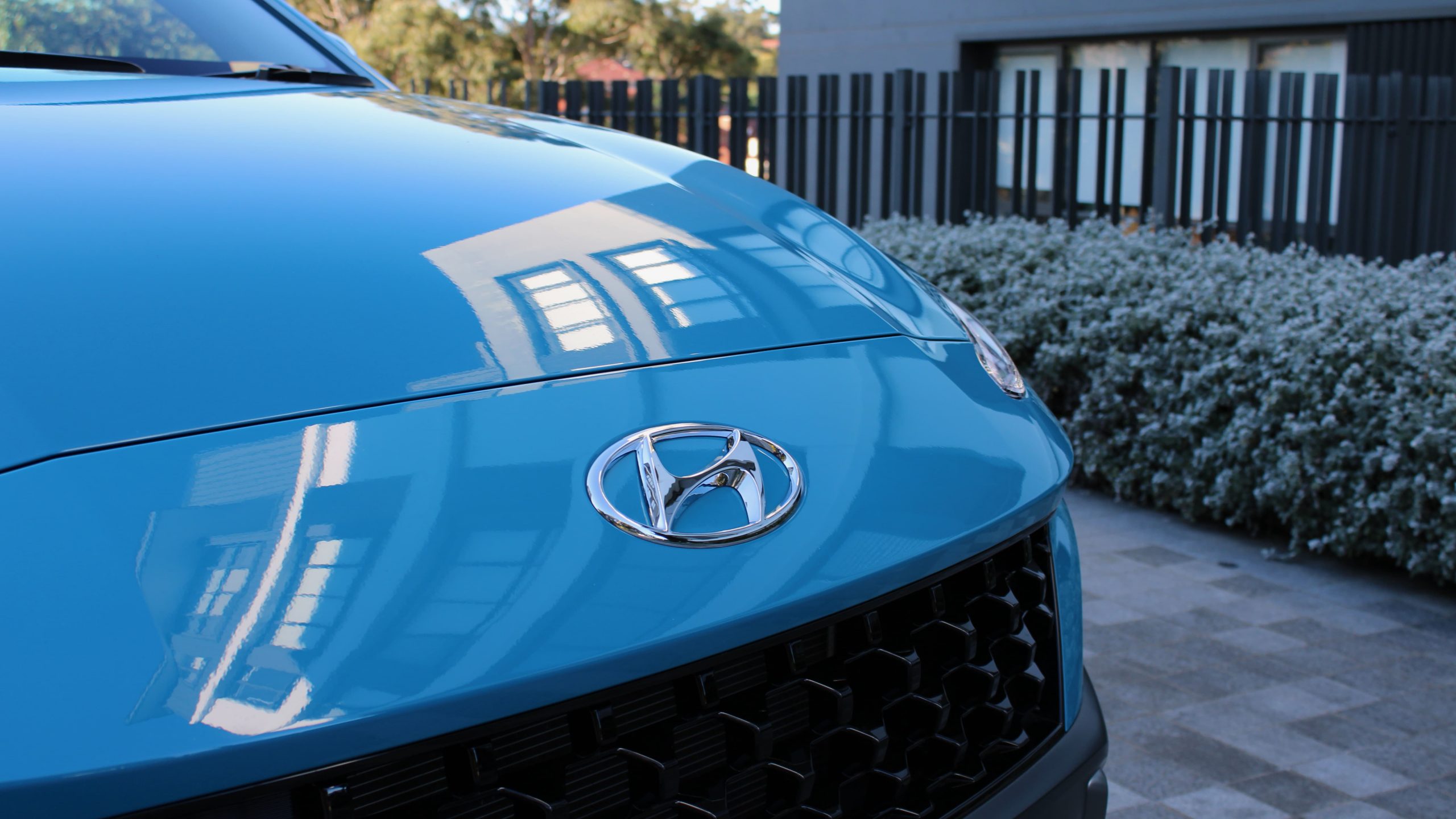

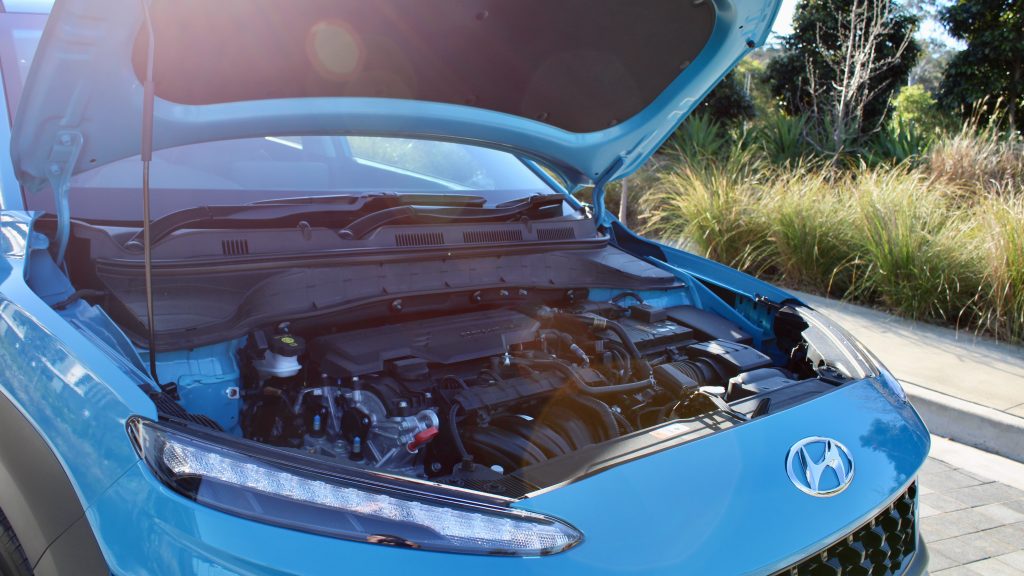
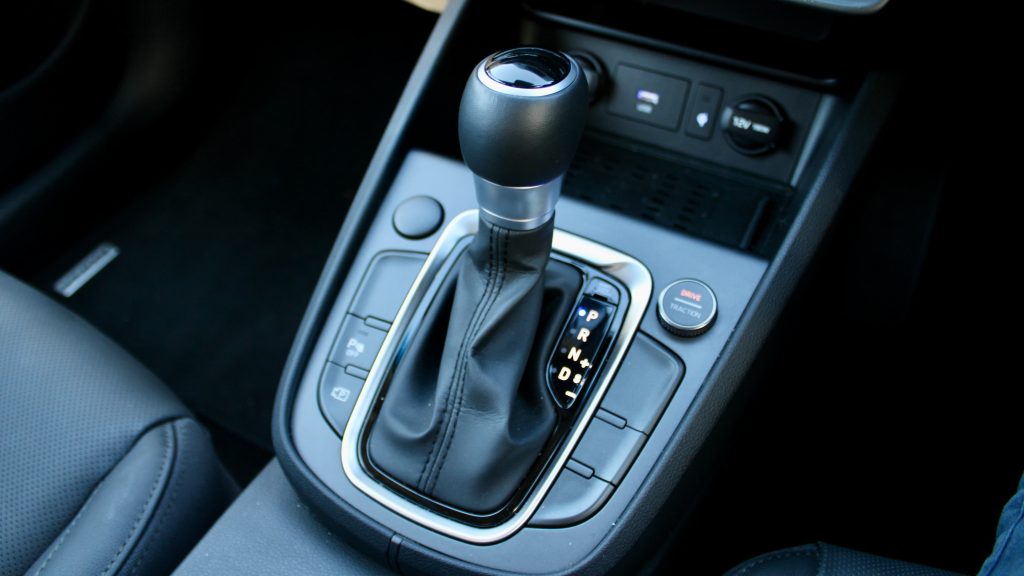
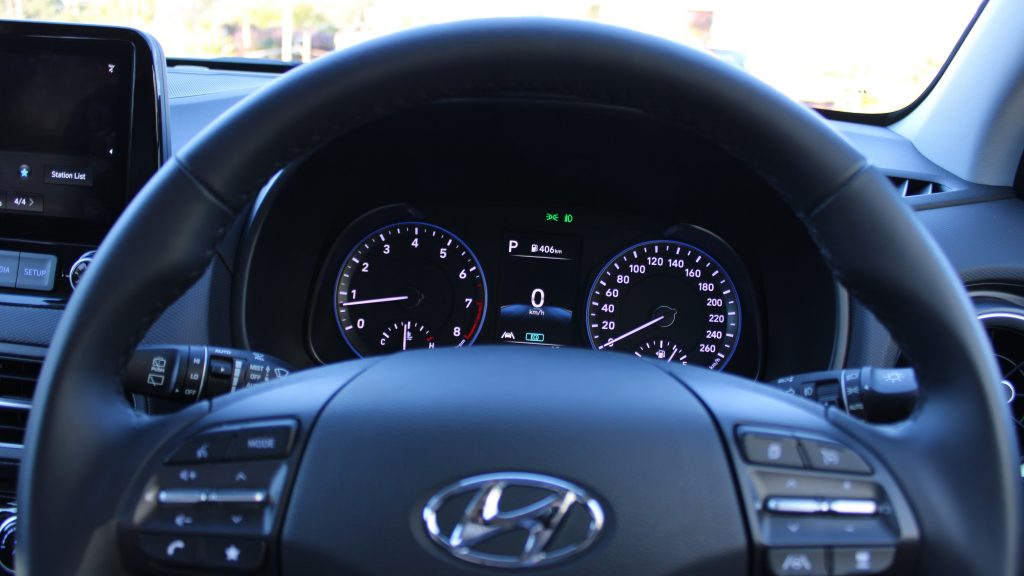
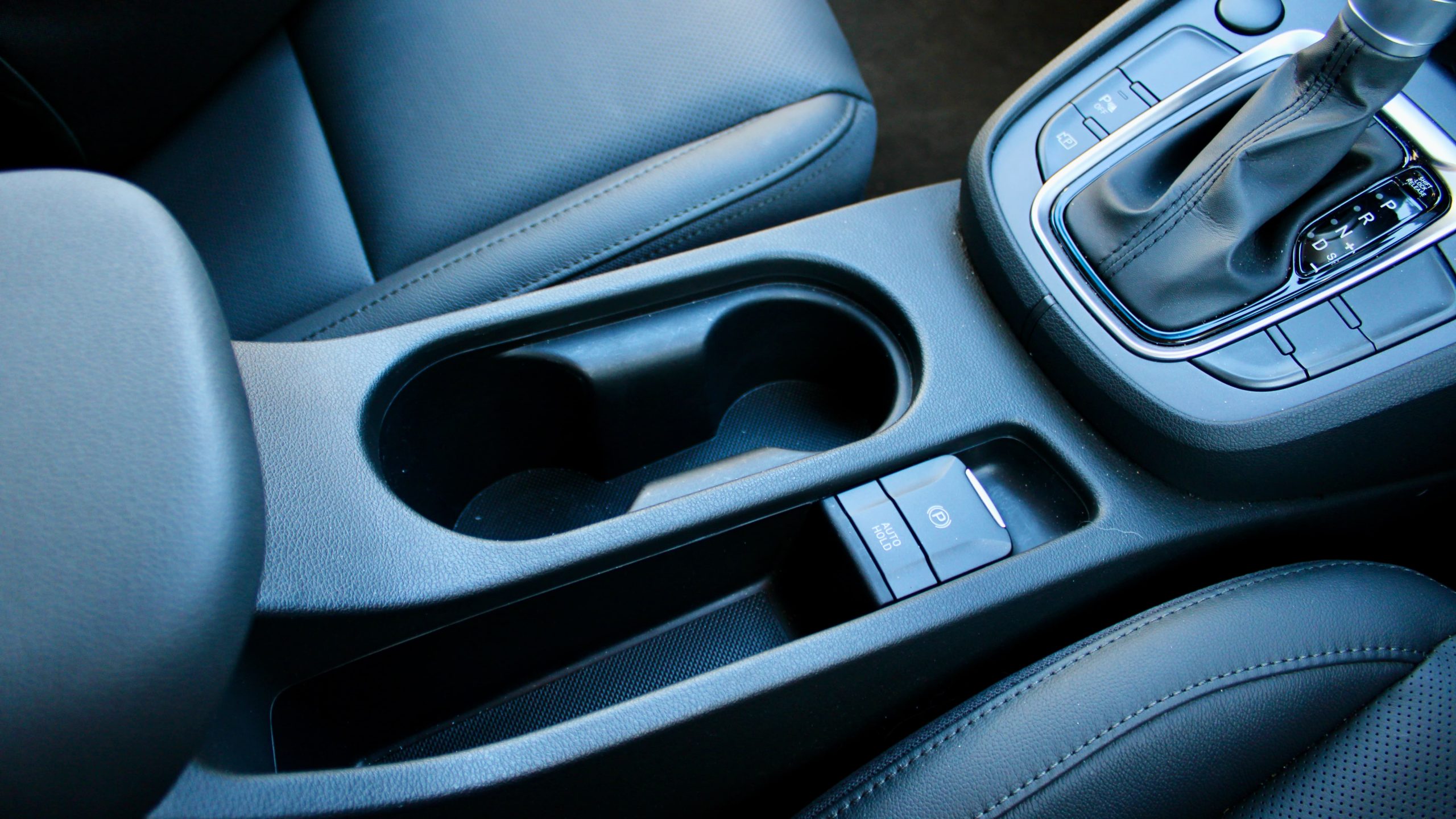
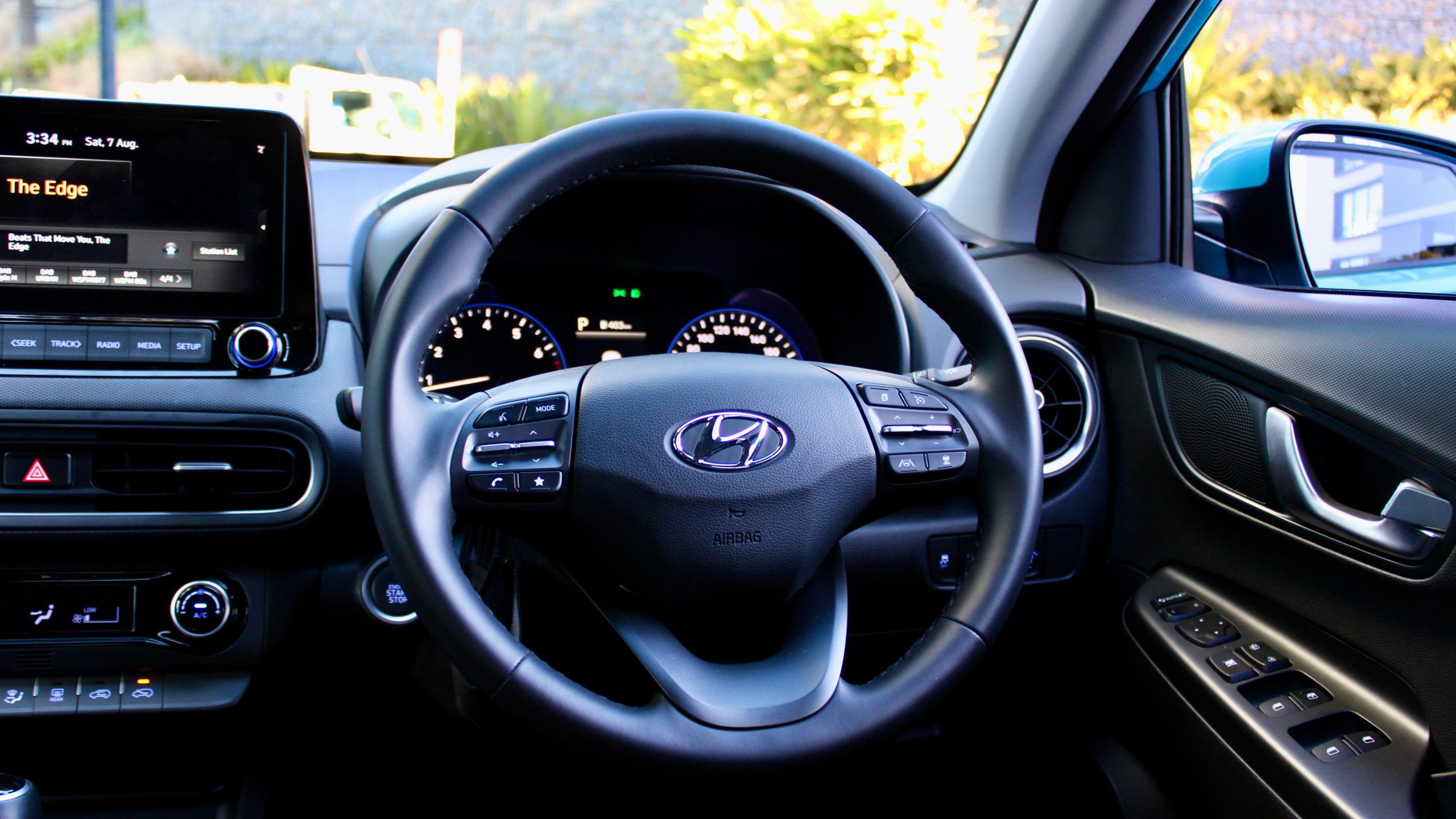
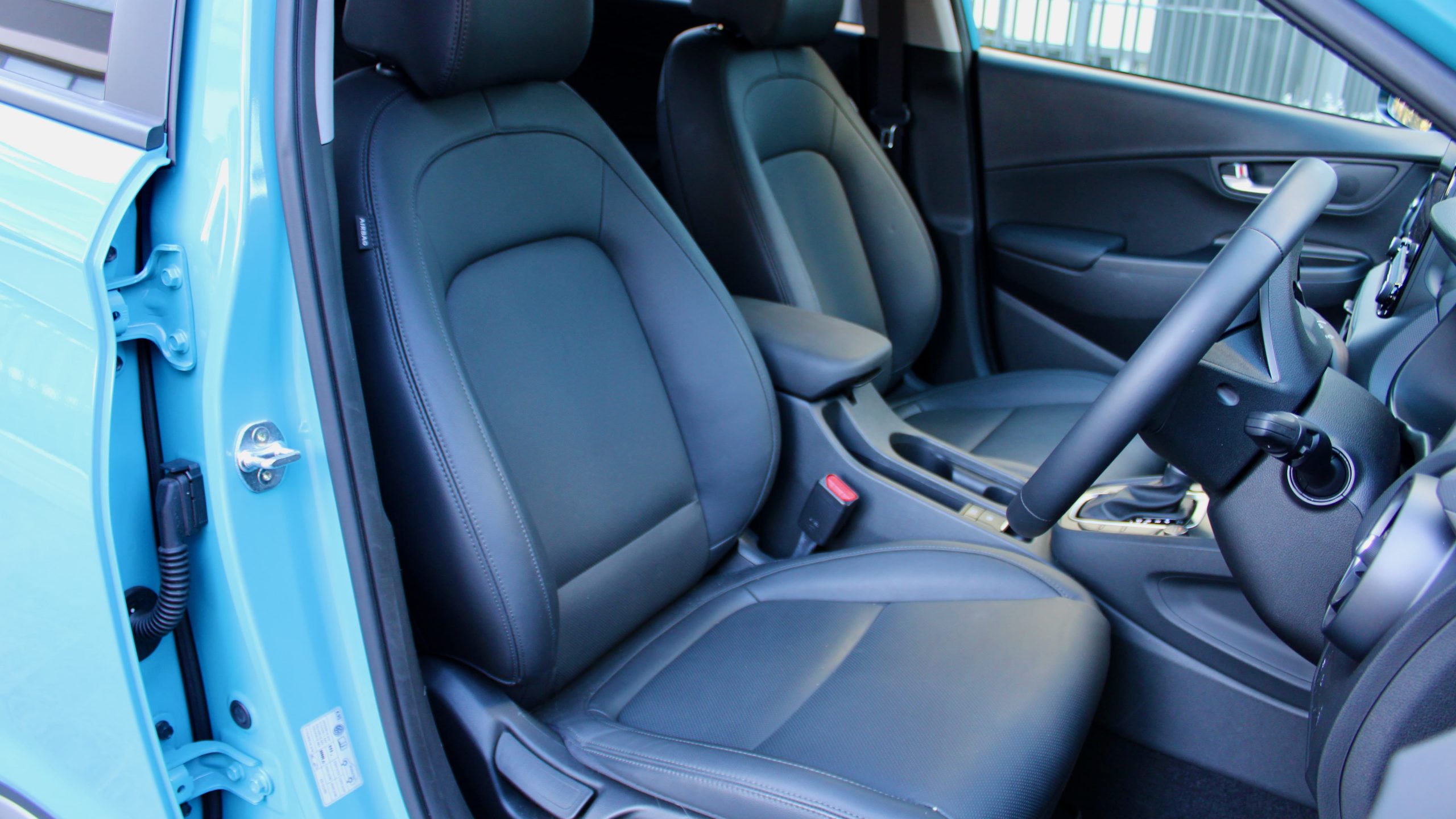
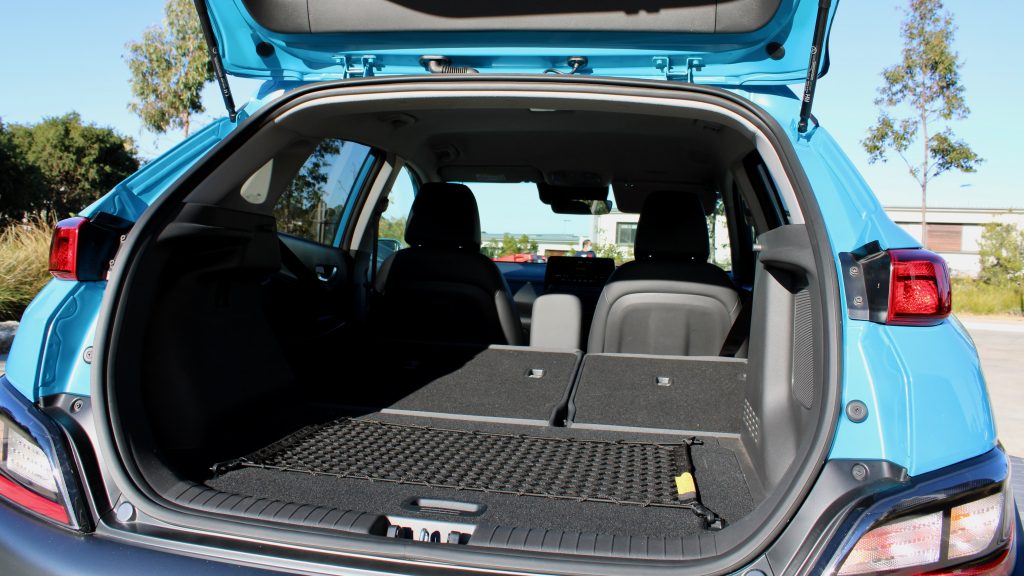
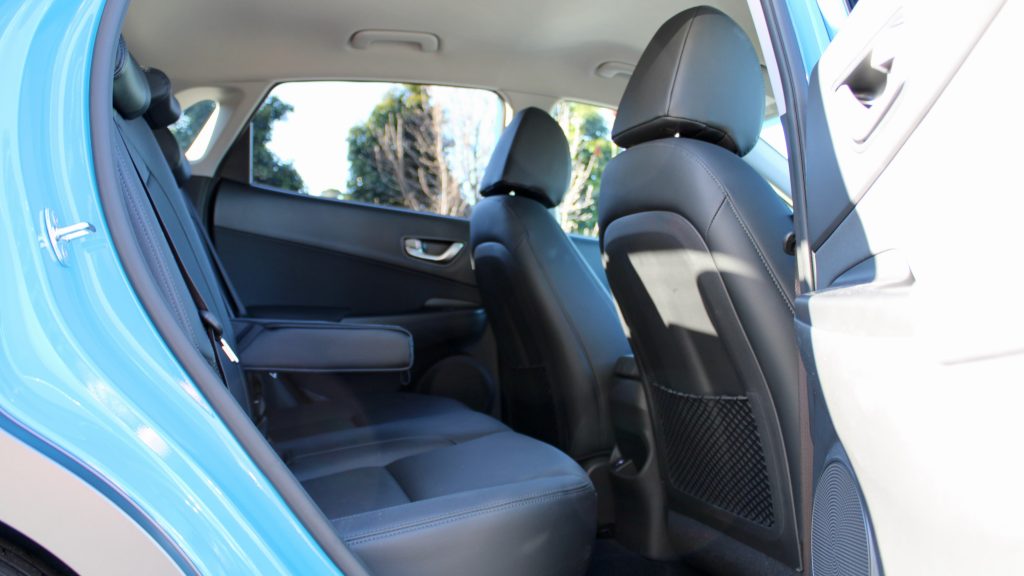
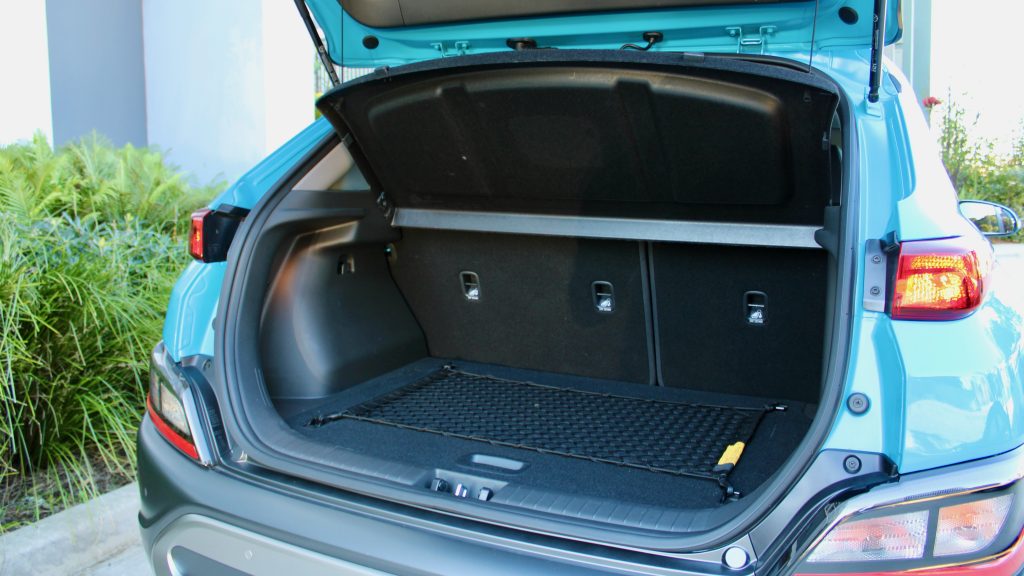
Hi Jordan. I thought you may have included the Skoda Kamiq as one of the Kona’s competitors. In your opinion, how would the Kamiq stack up against the Kona for ride. handling & road noise. Your feedback would be much appreciated. Regards, Shane.
Hi Shane,
Thank you for your comment. Yes, the Skoda Kamiq is a competitor to the Hyundai Kona. Its dimensions are smaller than the Kona but it offers more interior space and convenience. One of the reasons i didn’t include the Kamiq is at the moment they are transitioning from the 85TSI to the 110TSI and there are major stock shortages. The Kamiq is a truly fantastic small SUV and one of our favourites, the Kamiq is quieter for road noise and both cars ride very well. It is worth noting that the Kona is a touch sportier than the Kamiq as it has more power. Regards, Jordan.
Thanks Jordan